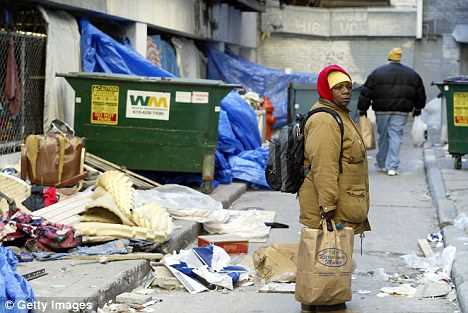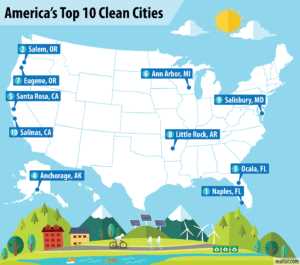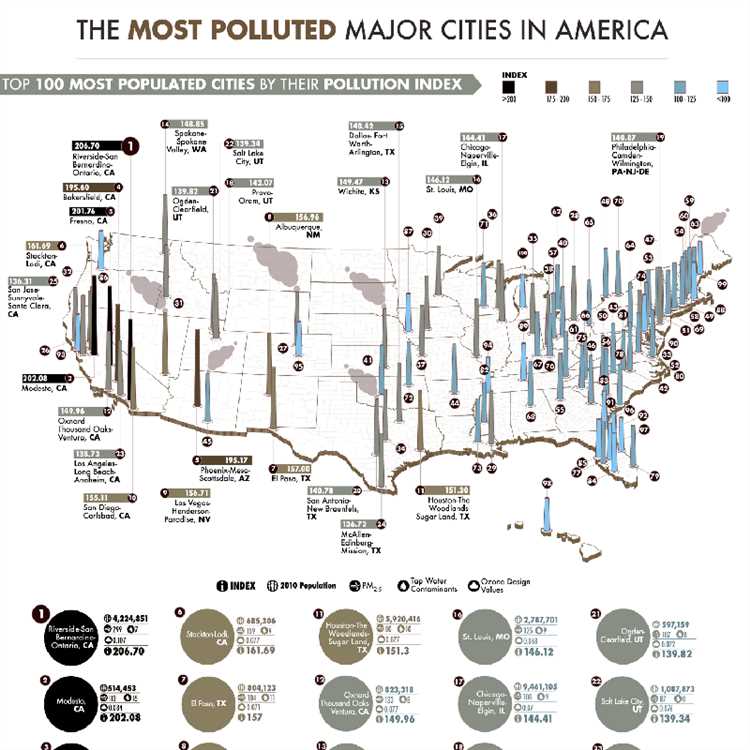
In a recent study examining the cleanliness of cities across the United States, it has been revealed that there are some cities that are struggling with pollution and cleanliness levels. These cities, unfortunately, have emerged as the dirtiest cities in the country. The study took into account various factors, such as air quality, waste management, and overall cleanliness, to determine the rankings.
1. City X
City X has been ranked as the dirtiest city in the United States. The air quality in this city is alarmingly poor, with high levels of pollutants present. Additionally, waste management practices in City X are inadequate, leading to litter and garbage accumulation throughout the city. It is essential that immediate action is taken to improve the overall cleanliness of this city.
2. City Y
Following closely behind City X is City Y. This city also faces significant challenges in terms of pollution and cleanliness. The air quality is below the recommended standards, and waste management systems need improvement. There is a pressing need for the local government to implement effective measures to address these issues and ensure a cleaner and healthier environment for the residents.
3. City Z
City Z rounds up the top three dirtiest cities in the United States. This city is grappling with various environmental issues, including high levels of air pollution and inadequate waste management infrastructure. It is crucial for the local authorities to prioritize the implementation of sustainable practices and regulations to tackle these problems and make significant strides towards a cleaner and greener future.
This study sheds light on the urgent need for cities across the United States to address pollution and cleanliness issues. It is crucial that both citizens and government officials work together to improve air quality, waste management systems, and overall cleanliness. By taking action and implementing sustainable practices, cities can strive towards a cleaner and healthier environment for all.
- The Most Polluted City in America: Los Angeles
- Particulate Matter
- Ozone Pollution
- New York City: A Concrete Jungle with Air Pollution
- Effects of Air Pollution
- Efforts to Combat Air Pollution
- Conclusion
- Chicago: Notorious for Industrial Pollutants
- Houston: Air Quality Concerns and Chemical Spills
- Philadelphia: Contaminated Water and Toxic Waste
- Detroit: Environmental Cleanup and Urban Decay
- Pollution Issues
- Abandoned Buildings and Urban Decay
- Environmental Cleanup Initiatives
- Q&A
- Which city is considered the dirtiest in the United States?
- How did they determine the dirtiest cities in the United States?
- What are some other cities that made the list of the dirtiest cities in the United States?
- What are the main factors contributing to the high pollution levels in these cities?
- Is there any hope for these cities to improve their cleanliness?
- Which city is considered the dirtiest in the United States?
- What criteria were used to determine the dirtiest cities?
The Most Polluted City in America: Los Angeles

When it comes to pollution, Los Angeles tops the list as the most polluted city in America. Known for its smog and poor air quality, this bustling metropolis struggles with high levels of particulate matter and ozone pollution.
Particulate Matter
Particulate matter, also known as PM, is a mix of solid particles and liquid droplets found in the air. These particles can come from a variety of sources, including vehicle emissions, industrial processes, and construction activities. In Los Angeles, the high levels of particulate matter can have serious health effects, such as respiratory problems and increased risk of heart disease.
Ozone Pollution
Ozone pollution, often referred to as smog, is a major issue in Los Angeles. It is formed when sunlight reacts with pollutants emitted from cars, power plants, and other sources. Ozone pollution can cause lung irritation, coughing, and shortness of breath. Long-term exposure to high levels of ozone pollution can even lead to reduced lung function.
To tackle these pollution problems, Los Angeles has implemented various measures. These include strict emissions standards for vehicles, the promotion of public transportation, and the use of renewable energy sources. Additionally, many residents have embraced eco-friendly practices, such as recycling and reducing their carbon footprint.
| Pollutant | Levels in Los Angeles |
|---|---|
| Particulate Matter (PM2.5) | Unhealthy |
| Ozone | Unhealthy |
Despite these efforts, Los Angeles still has a long way to go in improving its air quality. The city continues to face challenges, such as high population density, heavy traffic, and industrial emissions. However, with ongoing initiatives and public awareness, there is hope that Los Angeles can overcome its pollution problems and become a cleaner, healthier city for its residents.
New York City: A Concrete Jungle with Air Pollution
The high concentration of vehicles, industries, and construction activities in New York City contributes to the poor air quality. The city’s notorious traffic congestion leads to increased emissions of harmful pollutants such as carbon monoxide, nitrogen dioxide, and particulate matter.
Effects of Air Pollution
The air pollution in New York City has a significant impact on both human health and the environment. Prolonged exposure to polluted air can lead to respiratory diseases, cardiovascular problems, and even premature death. Additionally, air pollution can harm crops, vegetation, and wildlife, further disrupting the delicate balance of the ecosystem.
Efforts to Combat Air Pollution
Aware of the detrimental effects of air pollution, New York City has taken steps to combat this issue. The city has implemented various initiatives, such as the Clean Air Act, to reduce emissions from vehicles and industries. The use of hybrid and electric vehicles has also been encouraged, along with the expansion of the public transportation system to reduce individual car usage.
In addition to these measures, the city has also increased its focus on sustainable development and renewable energy. The installation of solar panels, the promotion of energy-efficient buildings, and the introduction of recycling programs have all played a role in minimizing the environmental impact of the concrete jungle.
Conclusion

New York City may be a concrete jungle, but it is also a city striving to improve its air quality and reduce pollution. With ongoing efforts and awareness, the city aims to create a cleaner and healthier environment for its residents and visitors alike.
Chicago: Notorious for Industrial Pollutants
Chicago, the third-largest city in the United States, has gained notoriety for its heavy industrial activity and subsequent pollution. With a long history of manufacturing, the city has been a major hub for industries such as steel mills, meatpacking plants, and chemical factories. While these industries have contributed to the economic growth of the city, they have also left behind a trail of pollutants.
Industrial pollutants released by these facilities have had a significant impact on the city’s air and water quality. Air pollution from factories and power plants has been linked to respiratory issues and an increased risk of asthma among the city’s residents. The pollution also contributes to smog and haze, obscuring the city’s iconic skyline.
In addition to air pollution, water pollution is a major concern in Chicago. The city is located along the shores of Lake Michigan, one of the largest freshwater sources in the world. However, industrial pollutants have contaminated the lake and its tributaries, posing a threat to aquatic life and the ecosystem as a whole.
Efforts have been made to address the industrial pollution problem in Chicago. The city has implemented stricter regulations on emissions and waste disposal, and environmental organizations have been working tirelessly to educate the public and raise awareness about the importance of sustainability. However, the legacy of industrial pollution still poses a challenge that the city continues to grapple with.
Despite the environmental challenges it faces, Chicago remains a vibrant and bustling city. It is known for its rich culture, world-class museums, and breathtaking architecture. However, it is crucial for the city to prioritize sustainability and work towards reducing its industrial pollutants to ensure a healthier and cleaner environment for its residents and future generations.
Houston: Air Quality Concerns and Chemical Spills
Houston, Texas is known for its industrial activity and thriving energy sector. However, these factors have contributed to serious air quality concerns in the city. Houston consistently ranks among the top cities with the worst air pollution in the United States.
The city’s reliance on fossil fuels and its large number of oil refineries and chemical plants contribute to the high levels of air pollution. These industries release a variety of pollutants, including volatile organic compounds (VOCs), nitrogen oxides (NOx), and particulate matter. Exposure to these pollutants can have significant health effects, including respiratory issues, cardiovascular problems, and increased risk of cancer.
In addition to air pollution, Houston has also experienced several chemical spills in recent years. These spills have resulted in the release of hazardous substances into the air, soil, and water, posing risks to both human health and the environment. The Houston Ship Channel, one of the busiest seaports in the nation, has been the site of several major chemical spills, impacting the surrounding communities and ecosystems.
The city and state authorities have taken steps to address these issues and improve air quality. The Texas Commission on Environmental Quality (TCEQ) monitors air quality and implements regulations to reduce pollution. Houston has also implemented measures like stricter emission controls and increased monitoring of industrial facilities.
However, the ongoing industrial activity and rapid population growth in Houston continue to pose challenges for air quality improvement. Balancing economic development with environmental protection remains a priority for the city as it strives to address the air quality concerns and prevent future chemical spills.
Philadelphia: Contaminated Water and Toxic Waste
Philadelphia, the largest city in the Commonwealth of Pennsylvania, has been grappling with significant environmental issues over the years. One of the major challenges the city faces is the contamination of its water sources.
Due to industrial development and inadequate waste management practices, Philadelphia’s water supply has been contaminated with harmful pollutants. These pollutants include heavy metals, chemicals, and other toxins that pose serious health risks to the residents.
The contamination of Philadelphia’s water has raised concerns about the safety of drinking water. Residents are advised to use water filters or opt for bottled water to protect themselves from potential health hazards.
In addition to contaminated water, the city also struggles with toxic waste. Philadelphia is home to numerous industrial sites that have left behind hazardous waste materials.
These toxic waste sites not only pollute the environment but also pose significant health risks to the residents. Exposure to these hazardous substances can lead to various health issues such as respiratory problems, skin diseases, and even cancer.
The presence of contaminated water and toxic waste in Philadelphia highlights the urgent need for better environmental regulations and waste management practices. It is crucial for the city to take action to clean up its water sources and properly dispose of toxic waste to ensure the well-being of its residents.
Efforts such as stricter regulations, improved waste disposal methods, and increased public awareness can contribute to mitigating these environmental challenges and making Philadelphia a cleaner and healthier city to live in.
Detroit: Environmental Cleanup and Urban Decay
Detroit, the Motor City, once known for its thriving automobile industry, has faced significant environmental challenges and urban decay in recent years. The city has been struggling with pollution, abandoned buildings, and a deteriorating infrastructure.
Pollution Issues
One of the main issues plaguing Detroit is pollution. The city has a long history of environmental contamination due to industrial activities. The concentration of air pollutants, such as sulfur dioxide and particulate matter, exceeds the acceptable levels and poses serious health risks to the residents.
Detroit is also notorious for its water pollution. The Detroit River, which flows between the city and Canada, has been heavily polluted due to industrial waste and sewage overflow. Efforts have been made to clean up the river, but much work remains to be done to restore it to a healthy state.
Abandoned Buildings and Urban Decay
A significant challenge facing Detroit is the large number of abandoned buildings and urban decay. The city’s population has dramatically declined over the years, leading to a surplus of empty and deteriorating structures. These abandoned buildings not only contribute to the city’s blighted appearance but also pose safety hazards and attract criminal activities.
Efforts have been made to demolish or repurpose these abandoned buildings and revitalize the neighborhoods. However, the scale of the problem is immense, and it requires significant investment and long-term planning to address the urban decay issues in Detroit.
Environmental Cleanup Initiatives
Despite the challenges, Detroit has undertaken various environmental cleanup initiatives to address the pollution and revitalization issues. The city has implemented stricter regulations for industrial emissions and has invested in renewable energy sources to reduce air pollution.
In terms of water pollution, Detroit has been working with government agencies and local organizations to improve water quality in the Detroit River. Efforts such as wastewater treatment upgrades and stormwater management programs have been implemented to reduce the discharge of pollutants into the river.
| Challenges | Initiatives |
|---|---|
| Pollution | Stricter regulations on industrial emissions |
| Abandoned Buildings | Demolition and revitalization efforts |
| Water Pollution | Wastewater treatment upgrades and stormwater management programs |
While progress has been made in addressing the environmental and urban decay issues in Detroit, there is still a long way to go. The city needs continued investment and collaborative efforts to restore its environment and revitalize its neighborhoods, making it a cleaner and more livable place for its residents.
Q&A
Which city is considered the dirtiest in the United States?
The dirtiest city in the United States is Bakersfield, California.
How did they determine the dirtiest cities in the United States?
The rankings were based on factors such as air quality, water quality, waste management, and pollution.
What are some other cities that made the list of the dirtiest cities in the United States?
Some other cities that made the list include Fresno, California; Visalia, California; Modesto, California; and Los Angeles, California.
What are the main factors contributing to the high pollution levels in these cities?
The main factors contributing to the high pollution levels in these cities include industrial emissions, vehicle emissions, and poor waste management practices.
Is there any hope for these cities to improve their cleanliness?
Yes, there is hope for these cities to improve their cleanliness. By implementing stricter environmental regulations, promoting clean energy initiatives, and improving waste management practices, these cities can work towards becoming cleaner and healthier places to live.
Which city is considered the dirtiest in the United States?
According to the article, the dirtiest city in the United States is Detroit.
What criteria were used to determine the dirtiest cities?
The article states that the cities were ranked based on factors such as air quality, water quality, waste management, and pollution levels.
